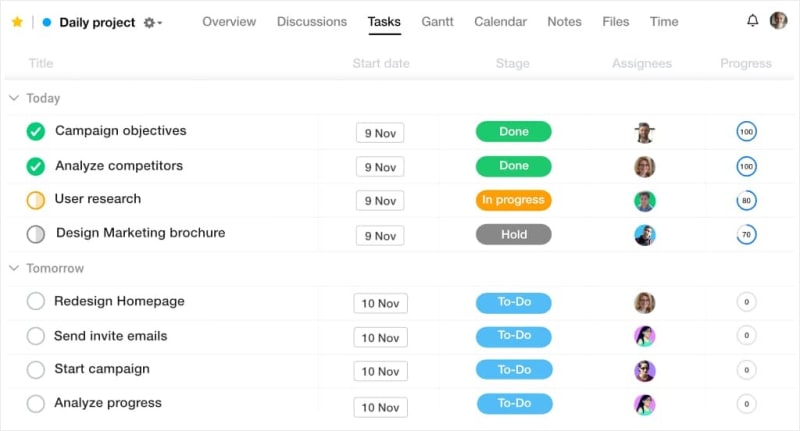“People are more productive working at home than people would have expected. Some people thought that everything would fall apart, and it hasn’t.” - Mark Zuckerberg
How quickly things can change! The unprecedented arrival of Covid-19 in the first quarter of 2020 gave little to no time to organizations across the world to shift to remote work.
Remote work was always considered as a stop-gap arrangement by businesses not too long ago. However, things aren’t the same anymore. Remote work has become the new normal and it will likely continue to remain in force for a long time to come.
That said, the rise of remote work has given birth to another concept i.e. hybrid work model, and it seems to fall perfectly in the gap between in-office and remote workspaces.
The Hybrid Work Model And The Role Of Effective Collaboration
The hybrid work model gives flexibility to employees to work from different spaces; they can combine work from home with work from coworking or even public spaces. And, if that doesn’t suit us, we can always lead lives as digital nomads. The flexibility of it all is both enticing and satisfactory.
As lockdown restrictions are eased in certain parts of the world, IT businesses have started to work from a physical office space albeit with only a handful of employees.
Only a few employees are working from a regular office space while many of them are still working from remote locations.
When it comes to web development, web developers have their tasks cut out - keeping an eye on latest web development trends, presenting design specs, maintaining and updating websites, creating and testing websites, collaborating with other designers, and so much more.
Hybrid web development teams have to be on the same page among themselves and with the design teams to ensure that their workflow is not affected due to a lack of collaboration.
We can say that the functioning of a web development application is directly related to how clear both designers and developers are on the website design requirements, and the results to be expected.
That said, achieving high collaboration for hybrid web development teams remains a challenge as team members might be working from areas with different time zones. Long, messy email threads, not following up in real-time, and time-consuming Zoom meetings are some obstacles that hybrid web developers have to overcome on the regular.
However, the good news is that the advancing technology has enabled hybrid teams to collaborate efficiently despite all the hurdles that they face. In this blog, we will take a look at six highly efficient collaboration tools that can help hybrid web development teams coordinate effectively.
7 Collaboration Tools That Hybrid Developers Must Use:
1. Miro

Miro is an online whiteboard and visual collaboration platform that is of great use for widely dispersed hybrid teams. Hybrid development teams can use this efficient collaboration tool for ideation and brainstorming, online meetings, research and design, mapping, and diagramming.
With more than 20 million users worldwide, Miro is packed with enterprise-ready security and advanced administration controls to facilitate seamless collaboration within hybrid teams anytime and anywhere.
Main Features:
- Sprint retrospectives
- Technical diagrams
- Mind mapping
- Task Management
- Digital sticky notes
- Pre-made templates
- App integrations
Pricing: A Free plan is available. The Paid plan starts from $8 user/month when billed annually.
2. ProofHub

ProofHub is a team collaboration and project management tool that can be used easily even by new team members due to its minimal learning curve and simplistic interface. ProofHub offers a wide range of features for hybrid developers to stay connected and easily collaborate with other departments.
This tool allows developers to assign, manage, and prioritize their tasks while tracking the time spent on them by using manual and automatic timers. The Group Chat and Discussions features allow for quick exchange of ideas and sharing of crucial information related to projects and tasks. The fixed pricing plans make it an affordable collaboration tool for startups and small businesses with a limited budget.
Main Features:
- Online proofing
- Task assignment
- Group chat
- Online discussions
- Gantt charts
- Kanban boards
- Scheduling calendar
- Stickies and Bookmarks
- The Table view
Pricing: The Ultimate Control plan is priced at $89/month when billed annually.
3. Range

Range is a useful team collaboration software that enables hybrid teams to check in with one another without resorting to video meetings, and still know what’s going on across the project. The main purpose of using Range is to reduce the dependency on team meetings for team collaboration.
Hybrid developers can check in asynchronously to get you the information you need to do your job without interrupting the flow of work. Range makes it easy to move some communications async as well as hold real-time discussions on crucial topics.
Main Features:
- Check-ins overviews
- Integrations overview
- Team directory
- Meetings overview
- Objectives overview
Pricing: A Free plan is available and the Paid plan starts from $8 per team member.
4. Zapier

Zapier is an online automation tool that enables users to automate recurring tasks by connecting two or more apps seamlessly. Hybrid teams can use Zapier to easily create and customize their workflow and integrate those apps that meet their requirements without any hassle.
Zapier offers its terms (Zap, Trigger, Action, Task) and language that can help hybrid teams to better understand what all that could be done for achieving better collaboration and productivity using this tool. The simple, fill-in-the-blank setup makes it easy to go from idea to execution within seconds through point, click, and automate.
Main Features:
- Drag and drop features
- Third-party integrations
- Application management
- Dashboard
- Zaps creation
- Tasks
- Import/export data through Google Sheets
- Connected accounts
Pricing: A Free plan is available. The Paid plan is available for $19.99/month when billed annually.
5. Trello

Trello is a collaboration and visual workflow management tool that offers hybrid teams a convenient, versatile, and visual way to collaborate, manage and organize their projects. The tool works like a Kanban board that you can customize according to your workflow requirements.
This visually appealing tool is easy to use and facilitates internal and external teams alike. Each Trello board contains lists that indicate the project progress. There are many options for hybrid teams to collaborate, provide updates, and share information on the go.
Main Features:
- In-line editing
- Drag-and-drop editing
- Data filters
- Automated Email notifications
- Information retrieval
- Mobile-friendly views
- Deadline alerts and notifications
Pricing: A Free paid plan is available. The Paid plan starts at $10 per user/month when billed annually.
6. V2 Cloud

V2 Cloud is a DaaS provider that allows you to easily deploy cloud-based Windows desktops in a few minutes. It's crucial to have the right infrastructure when working with a hybrid policy to assure better collaboration and productivity. Have a seamless and secure work environment either from home or at the office. With cloud desktop, you can access all your business data and apps from any device, from anywhere.
Main Features:
- Intuitive Management Console
- Third-party integrations
- Published Applications
- Web, Desktop and Mobile App
- Malware Protection
- Daily Backups
- Top Notch Live Support
Pricing: A risk-free trial is available . The basic plan starts at $40/month. Contract-free, with no minimum order or hidden fees.
7. Contractbook:

Contractbook is a cloud-based contract management software that aims to streamline the contract process for small and medium businesses. With Contractbook, users can create, edit, sign, and store contracts in one centralized location, making it easy to manage all of their legal documents in one place", so you don't need to worry how to edit a PDF contract anymore. The platform offers various features to help businesses automate their contract management process completely, starting from the creation of contracts and continuing even after post-sales hand-off.
Main Features:
- Customizable contract templates
- E-signature capabilities
- Automated contract reminders
- Contract analytics and reporting
- Collaboration tools for team members
- Contract negotiation and approval workflows
- Secure cloud storage for all contracts and legal documents
Pricing:
Contractbook offers a variety of pricing plans to meet the needs of businesses of all sizes.
Conclusion
As the hybrid work model rises in popularity, it’s up to teams across different departments to step up their collaboration game to ensure that there are no loopholes in planning, organizing, and execution. The five of the best collaboration tools featured here would help hybrid teams to stay on the same page by enabling team members to seamlessly connect with one another from any given location, at any time. So feel free to try them out! Good luck!






Latest comments (0)